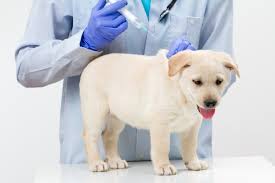Parvovirus is a word that strikes fear into the heart of every dog owner, but many people don’t actually know how to recognise the signs, how it is spread or what to do if you think your dog may have contracted it. So, here’s a brief overview to help make sense of what is a very serious disease for our furry friends.
Canine Parvovirus is an incredibly contagious disease. Some cells in the body reproduce rapidly and it is these type of cells that the virus tends to attack – cells such as those lining the gastrointestinal tract.
Once the dog is infected, the virus is deposited in the poo for up to several weeks.
The disease is transmitted by oral contact with infected faeces but it can be carried on the dog’s hair and feet, as well as on contaminated crates, shoes, and other objects.
When the dog licks the faecal material off hair, feet, or anything that came in contact with infected faeces, he acquires the disease.
The illness usually starts to show itself some 4-5 days after contamination.
Signs of Parvovirus include:-
Depression
Vomiting
Diarrhoea (which is profuse and contains blood/mucus)
Dehydration
There is sometimes, but not always, a high fever
Puppies with severe abdominal pain exhibit a “tucked-up” abdomen
Dog owners should suspect Parvovirus in all pups if they develop suddent vomiting and diarrhoea and contact their emergency vet straight away.
Treatment:-
Hospitalisation for intensive veterinary management.
Correction of dehydration and electrolyte imbalance (may take 3-5 days).
Introvenous fluids/medication to control vomiting and diarrhoea.
More severe cases may require blood plasma transfusions and other intensive care.
Antibiotics will be given to prevent septicaemia and other bacterial complications.
Puppies and dogs should not eat or drink until the vomiting has stopped. They do, however, still need fluid support during that time and this is one of the main reasons for the need to hospitalise the animal.
Outcome:
Many factors play a role in the final outcome such as which strain of Parvovirus has been contracted, the age of the dog, its immune status and how quickly diagnosis and treatment was administered.
With good veterinary care, most puppies will recover without complications.
Prevention:
Because Parvovirus is extremely resistant to most cleaning products and can in fact survive for months on crates, floors and other surfaces in general, it is advised to thoroughly clean and disinfect the quarters of infected animals with household bleach in a 1:32 dilution. The bleach must be left on the contaminated surface for 20 minutes before being rinsed.
N.B. Jeyes Fluid is often what people think of when cleaning contaminated areas. Please be aware that if the dog walks on it before it is dry, it is very dangerous as it absorbs through the surface of the pads and can actually poison your dog. Please always ensure you rinse the area and dry it thoroughly before any animal is allowed to walk on the surface, whatever you choose to use.

